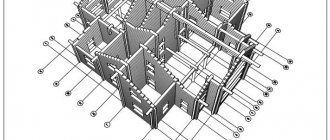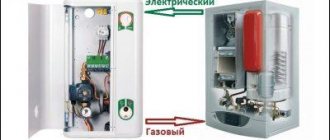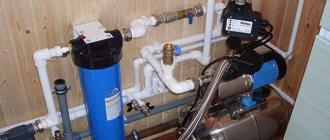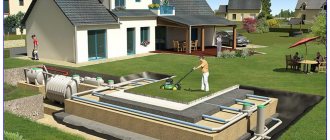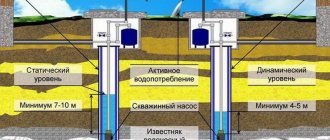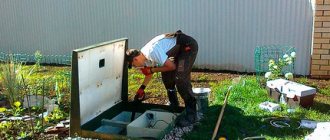Most areas and areas where holiday villages or country houses are located do not have a centralized sewer system. And yet, people, striving for maximum comfort and convenience, equip their homes with bathtubs, showers, baths, swimming pools, sinks, etc. In this case, the problem of centralizing all wastewater into a single system and its subsequent processing becomes urgent, as a result of which the purified liquid, which does not pose a threat to the environment, can be drained directly into the ground. And if previously ordinary cesspools were used for this purpose, now many residents are switching to special treatment facilities - septic tanks. These products collect, purify, settle and clarify sewage. There are many different modifications of septic tanks, and therefore, to choose the best option, you should carefully read their characteristics.
The principle of operation of septic tanks.
The treatment plant is one of the key parts of the sewer system.
The main function of a septic tank is the accumulation and treatment of wastewater from one or more structures.
The principle of operation of septic tanks
Treatment is carried out through physical and biological processes. In the first case, this is filtration and sedimentation, and in the second, the vital activity of microorganisms. Different types of septic tanks can process wastewater using one or more of the methods listed above. Also, the final degree of purity of the discharged liquid will depend on the number of cleaning stages. And depending on this, it will be discharged directly into the ground, into post-treatment systems, or into special storage tanks for further use for technical purposes (for example: watering plants or washing a car).
The internal part of the septic tank body may consist of one or several departments, in each of which wastewater is processed. The material used in the manufacture of the case is waterproof and has increased strength. Each of the products has a receiving section (or similar) into which wastewater from the sewer pipe initially flows. Here, settling of the liquid most often occurs, in which solid fractions settle to the bottom, and lighter ones rise to the surface in the form of a fatty film. A semi-clarified liquid remains in the middle. The biological part of processing consists of aerobic or anaerobic colonies of bacteria that decompose organic compounds into water, sediment (sludge) and a mixture of various gases.
We recommend reading the article about bacteria for septic tanks.Read
Ultimately, the sediment (silt) is pumped out by sewer trucks, and the clarified liquid is either gravity-fed or forcibly removed from the septic tank under the action of a pump.
As a result, the water ends up in post-treatment and recycling systems:
- filtration fields take the form of a network of perforated drainage pipes. The entire system is laid in trenches and covered with a mixture of sand and gravel.
- filtration wells look like ordinary wells (only without a bottom), in the lower part of which there is a filter (sand and gravel cushion more than 1 m thick).
- Factory-manufactured products (infiltrators) look like an inverted container. They are also installed on a sand and gravel bed.
- For the removal and accumulation of liquid, which has a purification degree of 95-98%, ordinary wastewater reservoirs and ditches are used.
The after-treatment device is selected based on the parameters of the exiting liquid (the degree of its purification).
The main condition that must be taken into account is that liquids with a purity level of less than 95%, according to the requirements of the SES, are prohibited from being discharged directly into the environment.
The principle of operation of septic tanks
Also, post-treatment plants can be installed only in those areas in which sandy, gravel, crushed stone or pebble soils predominate.
In places with predominantly clay soil, it is necessary to either connect to a central sewerage system (if available) or use local treatment plants (VOCs) that process wastewater up to 95% purity or more.
How to choose
In parallel with the construction of the house, a sewerage system is also being designed. Previously, they didn’t really care about this, and all the masses simply merged into cesspools.
Later they began to be replaced with septic tanks - containers for collecting wastewater from a residential building. To know which sump to choose, you should study all the factors that influence its location on the site.
Taking into account the type of soil
The type of soil on the site should be taken into account. Some of them are not suitable for use in clay rock, while others are preferable to be installed in sandy soil.
You should follow a few simple rules in your work:
- when groundwater is located at a depth of one and a half meters, it is difficult to prepare drainage for a three-section sump;
- on sandy soil it is preferable to install a container with biological treatment. The liquid is directly discharged into the sand, where it is absorbed. Filtration drainage is arranged closer to the surface;
- If the surface water is located at a high level, the option with deep biological treatment should be used. It is made heavier using improvised means or fixed.
Clay is an unstable material, which requires additional work in installing a sump. At the end of the frost, the structure of the clay changes, it thaws and pushes the structure out of the soil. Therefore, a septic tank in clay rock is equipped with additional metal fasteners during installation.
For containers used in clayey soils, two filtration fields are installed. To do this, two trenches are brought to the sump. One contains sewer pipes, and the other contains a layer of gravel, the height of which is up to 30 cm.
Seasonality and volume calculation
An important point when choosing the type of sump is the period of residence at the dacha or in your home. When installing a minimum set of plumbing fixtures, an inexpensive single-chamber storage option is quite suitable.
Despite its simplicity, it is qualitatively different from a cesspool. Sand or crushed stone is poured into the bottom of the storage tank. Thus, a filtration layer is formed that purifies wastewater with a 50% result.
For longer stays, you should purchase a compact two-chamber version. It consists of sections for settling and infiltration of wastewater. The use of this type of equipment is effective if the volume of drainage masses does not exceed its standard value.
Important: when purchasing a septic tank, carefully consider the choice of its technical characteristics. Particular attention should be paid to the number of residents it is designed for.
If you live permanently and have sufficient funds, it is better to purchase a whole station, consisting of two or three sections. It can be factory-made or constructed independently from reinforced concrete rings.
When constructing it, a single- or double-chamber storage tank and a filter section are combined. The settling tanks are made airtight, and the filtration septic tank has a drainage bottom made of sand and crushed stone. The liquid is pumped out from the storage sections using a vacuum cleaner, and the filter is changed every three years. This multi-chamber sedimentation tank purifies wastewater by 90%.
The volume of the device is calculated based on the average daily rate of sewage per person. This figure is 200 liters. Also, when calculating the capacity of the sump, the number of people living in the house and the possibility of accumulating a three-day supply are taken into account. For example, for a family of three people, the volume is calculated as follows: 200 * 3 people * 3 days - equal to 1800 liters.
Comparison of septic tanks with one chamber and multi-chamber ones.
In terms of performance, it is better to use devices with two or more departments.
A septic tank with one compartment is suitable for a home in which the volume of wastewater does not exceed 1 cubic meter. m. and the entry of fecal matter into the sewer will be prevented.
Multi-chamber septic tanks
Otherwise, the performance of the septic tank will drop and the need to call sewer trucks will become more frequent. The most optimal solution would be to install a multi-camera device. Mechanical treatment of wastewater will be carried out in the receiving department. Next, the semi-purified liquid enters the second section, in which the biological purification of water begins under the influence of bacterial colonies. As a result of their vital activity, organic matter breaks down into activated sludge, which precipitates; hydrocarbon gases removed through ventilation and purified water.
Single-chamber and multi-chamber septic tank
In local treatment plants there are third and fourth sections, in which additional sedimentation of liquid from sediment occurs. A septic tank compressor additionally saturates the wastewater with oxygen to increase the productivity of aerobic bacteria. The main disadvantage of VOCs is their energy dependence. This problem can be solved by installing an autonomous electric generator. For visual inspection and maintenance. For maintenance, all products are equipped with necks with inspection hatches. And if previously most septic tanks were made using concrete rings that had a huge mass and lacked tightness, now manufacturers can offer a variety of fairly lightweight and completely sealed structures.
Cost of purchase and operation
Economic factor is also one of the most important when choosing a wastewater treatment plant. Consumer costs consist of the costs of purchasing, installing and operating equipment. Naturally, each of these components depends, first of all, on the type of septic tank.
Storage septic tanks are the cheapest in terms of purchase and installation (construction) costs. However, the cost of their operation offsets these advantages - regularly calling out sewage disposal equipment to clean the chambers is quite expensive. As a result, such septic tanks are used only in summer cottages with seasonal residence, and only if the number of residents does not exceed 1-2 people.
In terms of purchase costs, overflow septic tanks are, as a rule, more attractive in price than stations with biological treatment (it is necessary to compare installations of the same performance). In addition, due to the lack of pumping equipment, they are, at first glance, cheaper to operate. However, this is only true as long as it does not concern the arrangement of filtration fields.
Their construction requires significant amounts of work to remove soil and lay filter layers and pipes. In addition, the filter layers require replacement once every 5-6 years. As a result, the total costs for the purchase, installation and operation of such septic tanks, all other things being equal, often turn out to be even greater than for multi-chamber devices with deep cleaning. Thus, modern septic tanks using biological methods of wastewater treatment are out of competition in all respects. This is especially true for a home for the permanent residence of a large family.
Septic tanks with an increased degree of purification.
In order to be able to further use purified water for technical needs, and sludge as a fertilizer, manufacturers produce products equipped with a biofilter. In such septic tanks, the cleaning process consists of mechanical and biological, including treatment with aerobic and anaerobic microorganisms. Among the disadvantages, it is worth highlighting their rather high cost.
How do sewage treatment plants work?
The compressor supplies small air bubbles to the aeration tanks, through which oxidation occurs. Then the wastewater is pumped into a biofilter or aeration tank, and the remaining organic matter is destroyed there. If you have an aeration tank, then a mixture of water and sludge is sent to a secondary settling tank, where the runoff is separated into water and sludge, and bacteria process organic matter. Aerobic bacteria are used here. The biofilter, in turn, uses anaerobic bacteria that can exist in an oxygen-free environment, therefore, there is no need for oxygen to enter the chamber. Purified water is either removed by gravity or using special mechanisms, leaving the sludge behind.
Choosing a location for a septic tank.
Choosing a place for a septic tank
One of the key points in installing a septic tank is choosing a place for its installation. A number of certain sanitary rules are associated with this. If they are not followed, the following may occur:
- unpleasant odors from the septic tank can penetrate indoors
- wastewater or semi-treated water can penetrate into open water bodies and groundwater, thereby polluting them
- improper installation of the device and its subsequent flooding during floods, rains, etc. can cause environmental pollution.
To prevent all unpleasant consequences, it is necessary to consider:
- The installation of the entire treatment system (especially the joints) must be absolutely airtight.
- the entire treatment system, including sewer pipes, must be located away from any bodies of water.
- the distance from the device to open sources of water must be at least 50 m.
- The septic tank should be located no closer than 5 meters to the foundation of the buildings.
- the distance to large vegetation with a highly developed root system should be at least 3 meters.
- the distance to the side of the road is at least 5 m.
- the distance to water supply pipes must be at least 10 m.
- it is necessary to think about the access of the sewer trucks.
The installation of a septic tank must be carried out according to a project previously agreed upon with the SES. Otherwise, this may subsequently result in an administrative offense. If the depth of the pit for the septic tank is more than 5 m, it will be necessary to obtain appropriate permission from the local municipality.
What should you consider when choosing a waste disposal device?
Before buying a septic tank, you need to answer several questions on how to choose a septic tank for your dacha:
- How many people will live in the house, what sanitary equipment will be installed? These factors determine the performance and volume of the septic tank.
- What are the features of the soil?
- What is the planned budget?
- Is it possible to connect to electricity?
- Can you make a septic tank yourself or do you prefer to buy a ready-made device?
Septic tank volume.
Septic tank volume
Most names of septic tanks have a numerical value indicating how many people the device is designed to serve.
It is better to select this parameter in strict accordance with the number of residents. A septic tank “with a reserve”, as a result of a lack of liquid, can dry out, which will cause the death of bacteria. The opposite situation will cause overcrowding of the device and its breakdown. There are also special formulas and tables for determining the required displacement of the device. But there is an easier way to calculate. According to the standards, wastewater should remain in the treatment plant for about 3 days. Accordingly, the total volume of the septic tank should be three times the size of the wastewater drained daily. For example, on average an adult resident spends about 200 liters. water per day. Naturally, this value is conditional and depends on the number and types of plumbing fixtures installed in the house. It is also necessary not to forget about the possible increase in the number of residents (guests, children) and select a device 30% larger than the original volume.
Autonomous sewerage
Septic tanks such as TOPAS, TOPOL, YUBAS, EUROBION, ASTRA, BIOXI and others.
These stations use a different treatment system, which allows the wastewater to be completely cleaned and discharged directly into the ground or some reservoir. They are perfect for permanent residence.
The work is based on the principle of an SBR reactor; the system operates flawlessly 365 days a year, but requires full maintenance, which of course slightly increases the budget for the entire sewerage installation process.
It is worth paying attention to an important nuance: you cannot pour household chemicals into this septic tank, or clean the pipes with it. Bacteria are the first to die when chlorine and other aggressive chemicals enter the septic tank.
Before choosing a system, you need to calculate the required power, which depends on the number of people living in the house. The service life of modern septic tanks reaches up to 50 years, so it is worth factoring into this figure possible guests and a larger family in the future. The name itself indicates a number; it indicates the maximum number of people who can use it.
There aren't many downsides to these setups, but they do exist. First of all, this is energy dependence; if the electricity is turned off, there is a risk of flooding the station and causing it to fail. Secondly, this requires maintenance every six months, which increases the cost of the entire installation.
Dimensions of the septic tank.
There are various models of septic tanks made in vertical and horizontal planes. Extended models are also available for areas with high groundwater levels. The choice of a vertical or horizontal model depends on the depth of soil freezing in the region. In cases with very high or unpredictable groundwater levels, an “anchor” is installed at the bottom of the pit under the septic tank. It is a concrete slab or similar structure to which the treatment plant is attached. When installing the device, you need to know that the neck should rise above the soil level by about 20 cm.
Selection options for a country house
There are also important selection criteria - the material of construction, the amount of drains and the type of soil with the groundwater level.
Materials
- Concrete. Durable option with self-assembly using formwork.
- Rings. Durable. Requires special equipment and sealing during assembly. How to make a septic tank from concrete rings.
- Brick construction. Sealing required. Difficult installation.
- Plastic containers. Lightweight, durable, but can be damaged by rodents. Destroyed at low temperatures.
- Metal. Sealed, durable. Subject to corrosion and needs protection.
- Fiberglass. Lightweight, durable, long lasting. Do not crack in frost.
Soil type and groundwater level
Soil parameters and groundwater levels also influence the choice. On soils that absorb water well and up to a groundwater level of more than 1 meter, it is better to install a sump with a drainage well.
And on soils with poor absorption capacity, a post-treatment system cannot be installed. And as an option, a septic tank or biological station is better. It is also worth doing if there is a large groundwater level.
Dimensions
The size of the septic tank is calculated from the amount of wastewater. It is generally accepted that there are 200 liters per person per day. And based on the standards, the capacity of the septic tank is calculated for the 3-day norm of each resident plus a 30% reserve.
From here another choice is made, for example, for wastewater less than 1 m3, a single-chamber septic tank is chosen. Less than 10 m3 - two-chamber, and if more than 10 m3 - then three-chamber. Homemade devices are calculated arbitrarily.
Soil for a septic tank.
Soil for a septic tank
Depending on the type of soil on the site, the installation of a septic tank will depend on:
- on sandy, gravel or crushed soil it is possible to install any type of septic tank. It is also possible to install any aftertreatment system.
- on soil containing clay, it is worth installing either conventional storage tanks or bio stations. cleaning. This is due to the almost completely non-permeable clay. Since the purified liquid cannot go into the ground, it is poured into drains or pumped out with a sewer truck.
Septic tank material.
Polymer septic tank
All modern septic tanks are made of polymers or metals. Among the features of polymer products it is worth highlighting:
- The simplest types of polymer septic tanks have the most reasonable price. In most cases, they are also equipped with special ribs that prevent them from “floating up”. Nowadays, there are several types of polymer devices:
- Septic tanks made of polyethylene have the lowest cost and have excellent tightness. Their main drawback is their reduced resistance to hot water.
- Septic tanks made of polypropylene are more durable and more resistant to aggressive environments and temperature fluctuations.
- Fiberglass septic tanks are the best polymer option, despite their higher cost. They have increased resistance to aggressive environments (including chemically active substances). They can be used to process industrial wastewater.
The service life of polymer products is more than 50 years.
Metal septic tanks have the following features:
- sensitivity to temperature fluctuations. When using the product in the cold season, it is necessary to properly insulate it.
- The metal for the device must undergo high-quality treatment with waterproofing substances.
Choice depending on housing material
When considering different types of septic tanks for a private home, it is necessary to select the optimal material for making the chamber housing:
- If a ready-made septic tank is selected, then its body, in most cases, is made of polymer materials. Fiberglass is less commonly used. Plastic can also be used to construct homemade septic tanks. These can be ready-made plastic containers of suitable volume; most often, Eurocubes are used for self-construction of the installation;
- Reinforced concrete is often used to construct homemade septic tanks for a private home. There are two options here: the construction of a prefabricated structure from ready-made well rings (produced by reinforced concrete factories) or the construction of a monolithic structure;
- You can use brick, preferably clinker, to build the chambers, since this material is not destroyed by water. When choosing this option, you will need to pay a lot of attention to sealing the chambers, since simple masonry easily allows water to pass through;
- The worst option is to use old metal barrels or tanks to build septic tanks. The metal is not resistant to corrosion and, even with high-quality treatment with anti-corrosion mastics, such a septic tank will not last long.
So, if you need to make a choice of treatment plant for the sewage system of a private house, you will have to compare septic tanks. In this case, you will have to take into account the mode of use, as well as local conditions on the site. Of course, you will have to take into account the cost of the septic tank, planned operating costs, as well as labor costs for its installation and subsequent maintenance. Only by comparing all the parameters of different models can you make the right choice and build an efficiently operating local sewage system.
Types of septic tanks. The most famous models.
The most famous septic tank models in terms of popularity are as follows:
- Septic tank Topas. A treatment plant that performs both mechanical and biological treatment of wastewater. Various modifications of the device can serve from 5 to 20 people. To clean a septic tank, it is not necessary to call a vacuum cleaner. Cleaning the septic tank can be done on your own using a drainage pump or airlift. The outlet water is sufficiently purified to be discharged directly into the ground.
- Septic Tank. Durable (service life more than 50 years) and durable (wall thickness from 10 to 17 mm.) product. Various types of devices can serve from 1 to 10 people. The peculiarity of the Tank septic tank is that to increase the productivity of the installation, it is possible to assemble several Tank devices into a single system. With a weight of 85 kg. capable of processing about 600 liters of wastewater per day.
- Septic tank Termite. The model range is represented by polypropylene products of various capacities. Depending on the modification, the internal space of the case is divided into 2 or 3 sections. The septic tank is capable of serving from small country houses to large country cottages. There is a model representing a bio station. cleaning. The purity of the liquid at its outlet is 98%. There are also regular Thermite storage tanks that do not have an outlet. As such a septic tank fills, it is necessary to call sewage trucks to clean it.
- Septic tank Astra Unilos. A self-sufficient system consisting of 4 departments and carrying out a full range of wastewater treatment. The product service life is more than 50 years with proper installation and further maintenance. When creating the Astra septic tank, the Topas treatment facility was taken as a basis. Therefore, these devices are structurally very similar.
- Septic tank Eurolos. The manufacturer produces four types of devices, differing in weight, size, volume and performance. Various modifications can serve from 2 to 30 people. Each of the septic tanks can be equipped with additional elements (eg: a pump for forced drainage of purified liquid).
- Septic tank Rostock. Various modifications of the device can serve from 1 to 6 people. All products consist of 2 chambers and the purity of the liquid at the outlet is from 70 to 80%. Accordingly, for the safe disposal of purified water into the ground, it is necessary to install treatment facilities.
- The Eurotank septic tank has a durable plastic construction with a wall thickness of 15 to 16 mm. To increase strength, the outside of the septic tank body is ribbed. The service life of the product is more than 50 years.
- Septic tank Poplar. A full-fledged treatment facility, consisting of 4 departments in which there is constant circulation of liquid. The liquid exiting the septic tank can be immediately safely drained into the ground, or can be used for technical needs.
- Septic tank Kolovesi. Finnish device made of polypropylene with a wall thickness of 8 mm. Various types of devices can serve from 2 to 11 people. From the inside, the body is divided into 4 compartments in which full mechanical and biological water purification takes place. If forced drainage of purified liquid is necessary, the septic tank can be equipped with a drainage pump.
- Septic tank Ural. Unlike all analogues, the device is made of vibration-compacted concrete, with a wall thickness of 100 mm. Thanks to this, the service life of the product is more than 100 years. The manufacturer produces various modifications of the Ural septic tank, capable of serving different numbers of people. This septic tank is mainly used for roadside cafes, hotels, etc.
- Septic tank Triton. Products are produced with wall thicknesses from 14 to 40 mm. Various types of products can serve from one to several private homes.
- Septic tank Biodeka. For private houses and summer cottages, the following modifications are mainly used: Biodeka 5; Biodeka 8 and Biodeka 10. The devices are made of an alloy of polypropylene and ethylene and have an operating temperature from +40 to -40 degrees.
Septic tanks perform a full range of liquid purification and at the outlet it can be discharged directly into the ground. When choosing a particular model of a treatment system, you should carefully familiarize yourself with its features and, at the same time, take into account the conditions in which it will be used.
Rating of domestic offers
The production of treatment facilities for local sewage systems on the Russian market began only a few decades ago. But over the years, many manufacturers have emerged specializing in this area.
The models of some of them are only copies of leading European brands, but still the majority are truly unique structures and structures.
Today on the market you can find models with different operational parameters, starting with primitive mini-septic tanks and ending with complex multi-stage treatment stations
Based on the results of a survey of consumers who actively use wastewater purifiers on their property, we have compiled a rating of septic tanks:
- Eurobion. The stations are the result of many years of work by specialists from the Yubas production association. Thanks to the use of innovative membrane technology and a rhythmic aeration tank, the stations can be operated even during long periods of downtime of the sewer system.
- Poplar. The products are famous for their high degree of purification, reaching 99%. By using a non-standard design in production, in which access to the primary chamber is open, the manufacturer has simplified the maintenance of the sections: large debris that impedes the operation of the sewer system can be removed from them independently.
- Aster. Septic tanks-settlers of the Unilos brand guarantee the removal of harmful components up to 75%. There are several modifications on sale depending on the number of consumers. The station, supplemented by a compressor, performs cleaning in several stages, due to which the wastewater that passes through it is permitted by sanitary standards to be discharged into a ditch.
- Tank. Products manufactured by . The model range includes compact tanks with a capacity of 600 l/day, and high-performance structures designed for 1200 l/day. Their parameters are identical to classic treatment plants with multi-stage wastewater treatment.
- Triton. Another popular product from this company. The model range of septic tanks of this brand includes several types, differing in configuration and cleaning method. Products of the “micro” and “mini” classes are designed for volumes of 450 and 750 liters, and storage tanks of the type with the letter designation “H” and “T” are designed for volumes of 10 thousand liters and above.
- Tver. The products of the trading house "Engineering Equipment" carry out wastewater treatment not only mechanically, but also biologically. The stations are equipped with a four-level wastewater clarification system and are designed to process waste from 750 to 1.5 thousand cubic meters per day.
- Topas. Products manufactured under this brand are characterized by low energy consumption. Four-chamber aerobic devices have a cleaning rate of up to 98%.
A distinctive feature of the products produced is the large thickness of the walls and the presence of stiffening ribs, thanks to which they can easily withstand large external loads.
They also do not float up even under the influence of floods, if their presence was not taken into account when choosing the design.
Almost all factory-made septic tank models offer the possibility of connecting additional modules to increase the capacity of the treatment plant
The treatment facilities of the Leader production enterprise are also no less popular. Polypropylene tanks of this brand carry out three stages of cleaning: mechanical, aerobic and biofiltration.
Rostok septic tanks produced by Rostok have also proven themselves well. The manufacturer specializes in the production of anaerobic treatment devices.
But, since the percentage of cleaning inside the chambers reaches only 65-70%, for the full operation of the structures it is necessary to install drainage tunnels.
The presence of designs with various parameters in the model lines of the listed manufacturers allows any consumer to make a rational choice, based on the optimal price/quality ratio.
